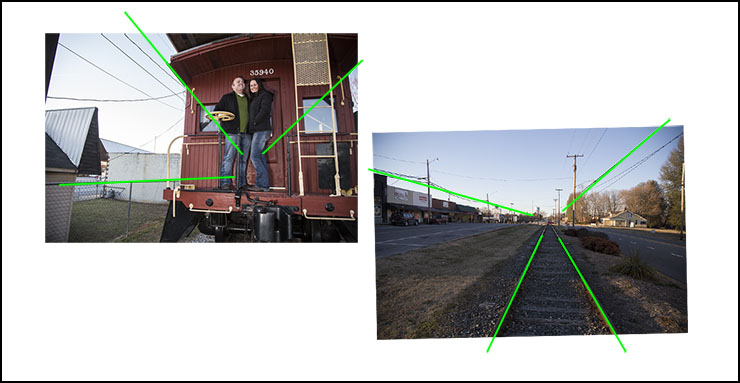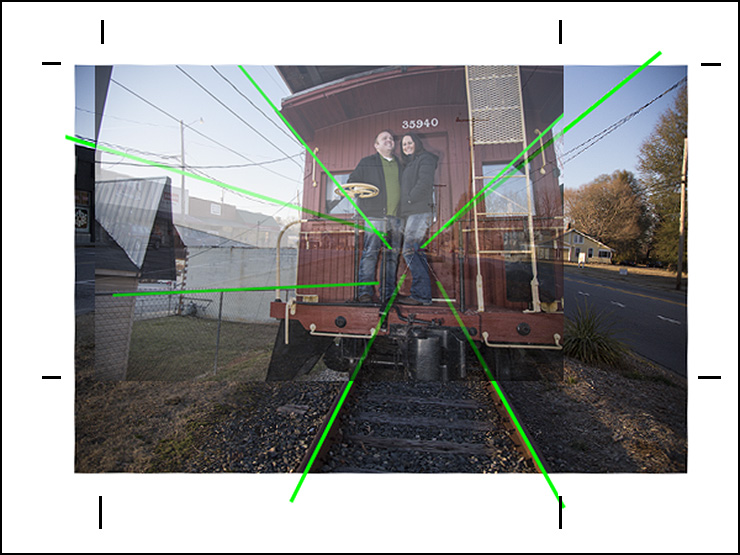|
(click the image for a better look)
A few months ago, Amy and I were driving through Hudson, NC, for perhaps the two thousandth time, when I was startled by the flash of a strobe along the mostly disused railroad tracks alongside US321A and the service road that is Hudson's main street. Someone had noticed a location that I had overlooked for years. My apologies and my thanks go to whomever was shooting on those tracks
that autumn afternoon. "Someday, I'm going to When Joanna asked me to shoot some engagement photos for her and Jeremy, that's the venue that immediately came to mind, and I tried to anticipate the light under which I imagined it might work best: low, clear evening light, with strong flash fill, the town largely in shadow, maybe with storefront lights. Let's all meet in Hudson around sunset, I suggested, and we did. It was cold out there in January. We started too early and the light wasn't working. We tried some interiors at The Local Bean which happened to be open late for a sweet 16 party. The light there wasn't happening, either. We wandered down to the old caboose in Windmill Park. I still wasn't happy with anything we were getting, but the light was improving, and I was encouraged that Jo and Jeremy seemed pleased by the way things were going. They were having fun, and that, I hoped, would show up in the photos. By the time we'd looped back to the tracks, the light was pretty close to what I had imagined. There's a link down below to the whole folio as presented to the happy couple. The last two images are what I thought the shoot was about, but I want to go on about one of my favorites, a bit of serendipity from earlier in the session. I was tagging promising frames when I realized two otherwise dreary images might be turned into something nice. One was a wide shot on the porch of the caboose; the other a simple "record" shot never meant for display but just to take note of the location for the rest of the shoot.
Each photo was made with a Canon 6D and a 24-105mm lens from about the same height of eye and aimed similarly with respect to the horizon. One used a Canon 580EX-II strobe held off-camera with a Rogue softbox for diffusion and the lens at 28mm while the other used no flash and the lens at 24mm. I always shoot with an eye toward what can be done in post-processing, so the drab color, low contrast, and uninteresting sky weren't concerns. They just signified that nothing was outside the dynamic range and color gamut of the raw data; color and luminance waited to be pulled out and put to work. But while tagging raw images, I thought that these two frames might come together in an interesting way. Rotate the righthand image to level the horizon. Find the vanishing point in each frame. As God is my witness, this is the first and only time I have ever actually used what I remember from those "You too can draw Mickey Mouse" art-instruction books that frustrated me no end when I was ten.
Lay the left photo over the one on the right taking care that the vanishing points coincide. Rescale the background photo until the first photo is completely surrounded. Make the first of many subtle adjustments to "sell" the final image: be sure the caboose's barely seen wheels line up with the even less-seen tracks.
Crop for composition and practicality. The caboose is cut off on the right, so you have to draw the edge of the frame there, and that pretty much determines the rest of the composition. Then go to work on the resulting stack. The tedious part is selectively erasing the landscape to the left of the caboose leaving only the streetscape of Hudson in the lower layer. Do the same for the glimpse of branches and blue sky to the right. Remove the roof covering the caboose at top center. Then hide the top layer leaving only the town. Using the "zoom" blur tool, experiment to find the appropriate amount of blur, and be sure it emanates from the shared vanishing point. Next, the light. As for Hudson, make it night. Increase saturation, pull down the transfer curves until only the blue of nightfall and a hint of fading sunset remain. Leave just enough light to provide an interesting wash in the sky and to silhouette the buildings and telephone lines. Bring back the top layer, the image of Joanna and Jeremy. Make a feature out of a potential problem: the primary light comes from a single strobe. Skylight softens it, but the deep shadows thrown to the right mean this is never going to look like a studio portrait. So don't try. Go the other way. These are two people standing at the end of a train rolling through town as the evening light fades. The only way to get that shot is with a flash. So emphasize the flash. The only questions you want to leave are: who are they, why are they so happy, where's that train going, and what are they doing on it? Evoke those questions and technical questions vanish, or, at worst, become logistical: where was the photographer to get that shot? I wasn't standing still, as can be seen from the blur; my motion is the same as the caboose's motion, but this is the caboose. Everyone knows that's the end of the train. So how did he do that? If that's all people wonder when they take a critical look at the photo, then I win. More "selling" points come into play. Light up the left side of the caboose and fade to the right. It needs to look like a really good photo with a single strobe rather than the half-baked mixed-light effort it was out of the camera. Be sure the yellow reflective paint looks as if it's harshly lit by a single source and not, as it was, by a palid mix of strobe and sky. Darken and blur the reflections in the caboose's windows so that no stationary leaves and wires ruin the sense of motion. Add or heighten catch lights. Don't try to remove the shadows behind Jo and Jeremy; darken them. Concentrate the light around the subjects a bit and let it fade in all directions — small, casual strobe, right? See that bright reflection off the top of the caboose? Keep and enhance that to heighten the effect of accidental light. The iron handwheel was lit in a particularly distracting way; even it out and then brighten it up selectively to bolster that single-strobe Warren Commission theory of the light — and for heaven's sake, now that we say it's lit from below and left, that wheel has to cast a shadow. Zoom way in and check everything as if with a loupe. The wheels should be blurred by rotation even if no one ever sees them clearly. Likewise the axle, but not nearly as much. The gravel of the railbed, the almost unseen rails: match the blur in the lower layer. Every detail counts, even — especially — the almost subliminal cues. Keep hiding and revealing the top layer to see how the composite looks. Adjust curves on each layer to keep contrast and black-points similar. When even you begin to believe it, you're getting close. Walk away and come back to it — does it still work? Whenever an odd detail catches your attention, decide why and fix it. Have some coffee; check the mail; let the dog out. Look again. Do that for a few hours and try not to get "The City of New Orleans" stuck in your head. When you keep making and reverting changes — going back to what you had a minute ago — you can start to call it finished.
They'll be gone 500 miles when the day is done.
:: top :: |
© 2015, David Cortner



